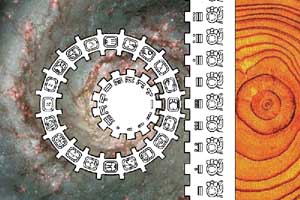Sticks, Stones and the Universe: Ancient methods to date events
By Steve KoppesNews Office
 The Compton lecture series, “The Age of Things: Sticks, Stones and the Universe,” will present a range of time scales from human history, where time can be measured using calendars, such as the classic Mayan calendar (represented above by the cogs in the foreground); to prehistory, when such techniques as dendrochronology (far right image) were useful; all the way back to when the universe formed (left background image from the Hubble Space Telescope). |
Learn about some of the various methods that scientists have used to date events from the ancient past at the 59th series of the Arthur Holly Compton Lectures, beginning Saturday, March 27.
The series of 10 lectures, titled “The Age of Things: Sticks, Stones and the Universe,” will be held Saturdays from 11 a.m. to noon, in Room 106 of the Kersten Physics Teaching Center, 5720 S. Ellis Ave.
Matthew Hedman, a Research Associate in the Enrico Fermi Institute and a Research Fellow in the Institute for Cosmological Physics, will deliver the lectures. His audience will learn how scientists from archaeology, cosmology and other fields examine the many time scales in the history of the universe, all the way back to the big bang more than 13 billion years ago.
Hedman received his B.A. in physics and anthropology from Grinnell College in 1996, and his Ph.D. in physics from Princeton University in 2001. He is a member of the University’s CAPMAP project, which is an effort to measure the polarization of the cosmic microwave background radiation, the afterglow of the big bang.
The Enrico Fermi Institute sponsors the Compton Lectures every spring and fall. Compton was a University physicist and a Nobel laureate best known for demonstrating that light has the characteristics of both a wave and a particle. He also organized the effort to produce plutonium for the atomic bomb and directed the Metallurgical Laboratory at the University, where Fermi and his colleagues produced the first controlled nuclear chain reaction in 1942.
The lectures are intended to make science accessible to a general audience and to convey the excitement of new discoveries in the physical sciences. Previous topics have ranged from the smallest fundamental particles to the history of the universe. All lectures are free and open to the public. For more information, call (773) 702-7823.
![[Chronicle]](/images/sidebar_header_oct06.gif)